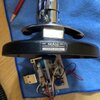Recently pickup this microphone. I’ve fixed several wiring/solder issues, pinched wires, wire strands on circuit board, cleaned the relays, stopped them from squeaking and I believe the 5k potentiometer is bad. The mic element is in fine shape and working great as tested on my other D104 mics.
Used a Jonard OB-1/3 burnisher tool on the contacts along with Deoxit D5.
Here’s the parts list. Planned on only replacing the capacitors unless forum wisdom says otherwise.
1. 5K Ohm Horizontal Slotted Wheel Trimmer Potentiometer
2. 4.7 uF axial capacitor
3. 47 pF capacitor
4. .1 uF capacitor
5. .01 uF capacitor
6. #102 capacitor
Any suggestions while I have it torn down?
Brad
KE0XS
South of Pittsburg



Used a Jonard OB-1/3 burnisher tool on the contacts along with Deoxit D5.
Here’s the parts list. Planned on only replacing the capacitors unless forum wisdom says otherwise.
1. 5K Ohm Horizontal Slotted Wheel Trimmer Potentiometer
2. 4.7 uF axial capacitor
3. 47 pF capacitor
4. .1 uF capacitor
5. .01 uF capacitor
6. #102 capacitor
Any suggestions while I have it torn down?
Brad
KE0XS
South of Pittsburg



Last edited:











